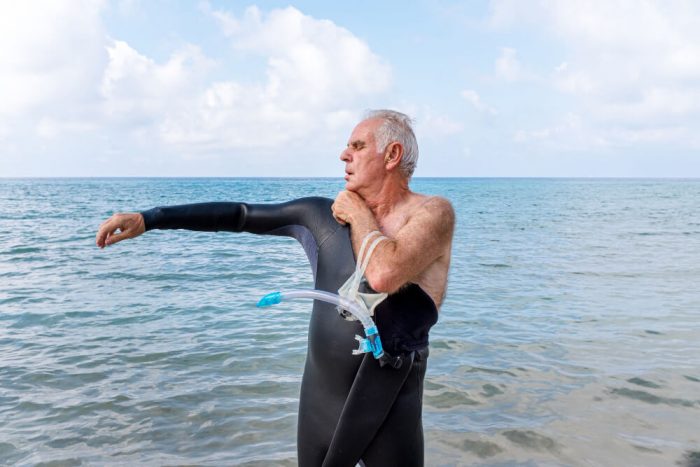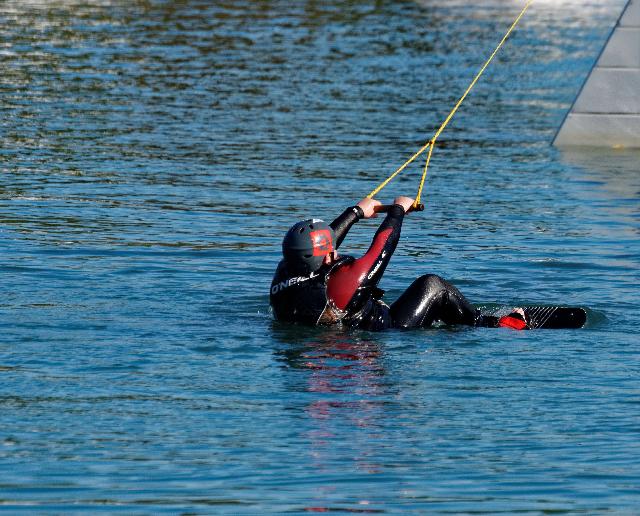The difference between wet suits vs drysuit is in how they work with water. The Wet suit has a thin neoprene lining that allows water to easily pass through it and keep warm while on land. The dry suit has a PVC lining which increases its resistance to cold water and makes it suitable for colder waters too. Wetsuits are better for extreme water sports like surfing or diving, while dry suits are best for colder water such as snorkeling and swimming.
Key Takeaways
- A drysuit could be the best option when you are kayaking in water temperature under 45 degrees or in air temperature under 50 degrees
- Wetsuits are the best option for waters between 45 and 70 degrees and if you are paddling, surfing, swimming, etc.
- Usually, a wetsuit keeps a thin layer of water to heat up your body
- A drysuit will keep your body completely dry
- Wetsuits are one-piece suits and they are made of neoprene
Wetsuit VS Drysuit: The Quick Differences
Wetsuits could be the best option for paddling, surfing, swimming, and other activities in waters between 45 and 70 degrees.
A drysuit could be the best option when you are kayaking in water temperature under 45 degrees or in air temperature under 50 degrees. Therefore, whether you will need a drysuit or a wetsuit is dependent on the activities and temperature you will be kayaking in.
| Wetsuits | Drysuits |
| Great for surfing, swimming, and kayaking | Great for extremely cold conditions |
| Keep a thin layer of water to heat up your body | Keep your body completely dry |
| A bit difficult to get in and out of | Easier to get in and out of |
| One-piece | Require several other layers of clothing underneath |
| Better buoyancy | Most don’t come with a relief zipper |
In this article, I will answer the difference between a wetsuit vs. a drysuit for kayaking in detail ahead. But, let’s define the condition that requires the suits.
When Should A Kayaker/Swimmer Wear A Drysuit or Wetsuit?
The most important thing to keep in mind is that both suits have their own advantages and disadvantages, so it’s best to think about what type of conditions you’ll be playing in before choosing one over the other.
Wetsuits are typically used when a person is playing in cold water. They protect you from the cold and help your body regulate its temperature. They are also used when you have to stay in the water for extended periods of time, like during a race, for example.
Drysuits on the other hand are primarily used when you are playing in warm water. They prevent your body from getting wet and protect your skin from sunburns and skin damage.
Here are more reasons to learn about:
Cold Water Paddling
A cold water situation occurs anytime the temperature of water drops below 60 degrees Fahrenheit (16 degrees Celsius). The cold water situation can occur when the combined air and water temperature is less than 120 degrees Fahrenheit, given the water temperature is above 60 degrees Fahrenheit.
When cold water condition occurs, paddlers need to suit the water temperature. It’s because an accidental swim could cold shock, eventually death!
Here’s how an unprotected swimmer is likely to suffer from an accidental swim in cold water:
1. The unprotected swimmer will suffer cold shock for one minute
2. Within 10 minutes, the swimmer will feel numb
3. Then, within an hour, he/she will succumb to hypothermia if he/she doesn’t drown before then
Lifesaving Society Facts
According to a survey conducted by the Cold Water Boot Camp, it is found that 86% who died in cold water didn’t wear a life vest. The rest who wore either didn’t wear a life vest properly or were further away from the shore or safety.
Therefore, it is clear that wearing a life vest can increase your odds of survival in cold water significantly.
Dresses For Immersion
The water temperature can drop drastically during cold weather. Therefore, you need to dress up, especially in order to handle the temperature. The practice is known as the dressing for immersion. Water temperature is deadly, it can drain warmth away from your body.
However, a wetsuit or a drysuit is what stokes up the debate. Actually, which type of suit you will require is dependent on several factors. Today, we are going to learn about the factors. And, I will discuss each of the suits in detail. So, keep on reading.
Wetsuit Overview In Detail
Wetsuits are one-piece suits. The suits are designed to allow a thin layer of water to come in contact with your skin. The wetsuits are quite a snug fit, therefore the water is kept in contact with your body. The secret to storage is neoprene. Yes, neoprene is the material that forms the construction of a wetsuit. By keeping the water in contact, the suit, in turn, gets your body warm.

Wetsuits are historically used for cold water surf sports. The neoprene material allows flexible movement, and is quite snuggly as well! Be aware that your wetsuit remains snug. If it gets too loose, you are likely to get cold.
How Do Wetsuits Work?
A wetsuit uses neoprene to trap and hold a thin layer of water next to your body. Your body heats up the layer, and the paddler can keep warm in turn. The thicker the neoprene, the less flexible it tends to be.
Types Of Wetsuits
1. Full-Body Wetsuits: These are the most common type of wetsuits. They are made from neoprene, a synthetic rubber that is inherently buoyant. This material is also lightweight and provides a high warmth-to-weight ratio. Full-body wetsuits are among the warmest and most buoyant wetsuits, providing excellent insulation in cold water. Cover your torso, arms, wrists, legs, and ankles.
2. Neoprene: Neoprene is inherently buoyant and lightweight, providing a high warmth-to-weight ratio and a soft, comfortable fabric for the wearer.
3. Short-Sleeve Wetsuit: A short-sleeved wetsuit is like a long-sleeved one. The only difference is that a short-sleeve wetsuit comes without sleeves. Cover your torso, thighs, and upper arms.
4. Lycra Wetsuits: Lycra is a fabric that is designed to be durable and stretchy so that it can easily move with the body. Wetsuits are made from Lycra so they can be flexible and absorb water quickly. This makes them ideal for swimmers, divers, surfers, and people who enjoy water sports. This type of wetsuit is stretchy and comfortable but is not as durable as other types of wetsuits.
5. RTR Wetsuits: RTR Wetsuits are pieces of clothing that keep you warm and dry in the water. They use a revolutionary material called NanoFlex, 100% waterproof and breathable, that can stretch with you as it keeps you warmer.
6. Short John Wetsuits: Cover your torso and thighs
7. Long John Wetsuits: Cover your torso, legs, and ankles
Drysuits Overview In Detail
A dry suit keeps the water completely away from your body. To achieve such quality, a dry suit combines a waterproof fabric that covers your neck, wrist, and ankles. Drysuits have gaskets to ensure that your body remains waterproof.
Gaskets seal tightly against your body and prevent the water from coming in. Gaskets seal your body around the neck, wrists, and sometimes even ankles. A drysuit is an outer layer though. You have to wear a base and mid-layer to stay warm.

How Do Drysuits Work?
Drysuits work by trapping the moisture in the air and keeping it from seeping into the suit. They also keep the wearer’s body temperature regulated and prevent water from entering the suit.
Drysuits are typically worn by divers and mountaineers who are in cold environments. They are made out of waterproof and breathable materials with a thick wetsuit underneath. The wetsuit material is porous, which allows water vapor to escape, but prevents water from entering. The membranes that make up the drysuit are typically made from silicone rubber. The membranes are sealed to the wetsuit on the outside by a rubber coating.
Types Of Drysuits
1. Membrane Dry Suits: Membrane dry suits are designed to protect the wearer from the environment and protect the equipment. They are made of a polymer membrane that is impervious to oils, gases, and water impurities. Membrane dry suits are a type of wetsuit that is worn over a dry suit to keep the body dry in cold water. They are mainly used by divers who need visibility in cold water.
2. Neoprene Dry Suits: Neoprene dry suits are a type of wetsuit that is made from a hydrophobic, elastomer material that keeps the wearer dry and warm in cold and aquatic environments. These suits are popular among swimmers and divers because they help prevent hypothermia, and buoyancy control, and assist in navigation.
3. Hybrid Dry Suits: A hybrid dry suit is a must-have item for every diver. These suits are made to provide the best protection against cold water, while still being flexible enough for easy movement. Hybrid dry suits are usually made from neoprene or silicone sealant and merino wool. A hybrid drysuit is a type of dry suit that allows for the use of a wetsuit beneath it.
4. Scuba Dry Suit: Scuba dry suits are a type of diving suit that is largely made from neoprene, a synthetic rubber. They are worn primarily to protect divers from cold water’s adverse effects and prevent them from getting wet. What is a dry suit that people wear under the water to keep them from getting wet? A scuba-dry suit allows people to go beneath the surface of the water without having to worry about any water getting in. Scuba-dry suits are made of neoprene, which is an elastic material that can stretch and resist pressure.
Final Thought
Many ignore the importance of a cold-water suit, they eventually succumb to cold shock, which could lead to cold incapacitation, even hypothermia. Hopefully, you won’t be one of them. Learn which life vest you should invest in – a wetsuit or a drysuit.
References:
- https://www.surfdome.com/blog/wetsuit-vs-drysuit
- https://mustangsurvival.com/blogs/resources/the-difference-between-wetsuits-and-dry-suits
- https://www.scuba.com/blog/scuba-gear/what-is-the-difference-between-a-wetsuit-and-a-drysuit/

Rockey is a kayaking enthusiast who has been kayaking with a local group for the last five years. He loves using kayaks while out on outings on the water or camping when the friends want to have a BBQ party somewhere on the bank of a local lake. More About James R Rockey at About Page Here: Authors
Based on his experiences with the different types of kayaks, he is sharing his opinion about kayaking tricks and required gears so that a beginner can get started right away.
Find his team on Twitter here. Happy reading!
